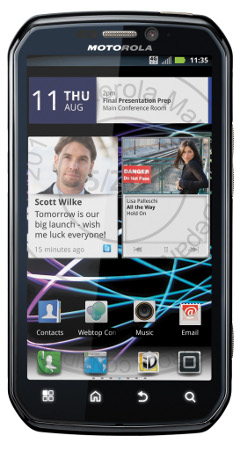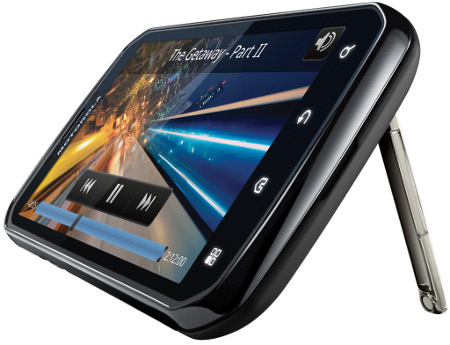Zippy Motorola Photon 4G upstaged by HD Station accessory
Aug 2, 2011 — by LinuxDevices Staff — from the LinuxDevices Archive — viewsMotorola's Photon 4G is a fast, solid multimedia smartphone, featuring Android 2.3 on an Nvidia Tegra 2 processor and an eight-megapixel camera, says this eWEEK review. Yet, the fun really starts with this Sprint 4G phone when you buy the optional Motorola HD Station and begin pushing content to an HDTV.
The Motorola Photon 4G is one of the better smartphones on the market for multimedia consumption. It even boasts a kickstand to prop up the device while listening to tunes or watching YouTube clips and other content hands-free. The Android 2.3 ("Gingerbread") handset, which Sprint began selling last week for $200 on contract, can also be connected to an HDTV with an optional dock, letting you port music, photos, video and other content onto a larger screen.

Motorola Photon 4G
(Click to enlarge)
The Photon's eight-megapixel camera shoots great pictures, captures HD video in 720p, and plays it back in 1080p. A front-facing VGA camera for video chat worked okay using Qik.
Watching videos and listening to tunes, as well as sharing such content through the media gallery, is a blast. The phone speeds data via the dual-core, 1GHz Nvidia Tegra 2 processor and Sprint's 4G WiMAX network. The device boasts 1GB of RAM and 16GB of onboard memory, expandable via a 32GB SD card, for up to 48GB of storage.

Photon 4G on kickstand
(Click to enlarge)
Calls were crisp on this so-called "world phone," and you can make them near and far. The phone supports WiMAX 2500, CDMA 800/1900 (Code Division Multiple Access 800/1900), WCDMA 850/1900/2100, and GSM 850/900/1800/1900 bands. The Sprint wireless hotspot capability will support up to eight 4G or 3G devices, as long as you don't mind spending $30 a month for the perk.
Motorola claims 6.5 hours of video playback and 10 hours of talk time for the 1700mAh battery. I did spend one whole day just doing normal texting, calling, and emailing with occasional web data use, and the device lasted 10 hours. Constant video playback and multimedia access dragged life down to two hours, however.
HD Station shines
The real joy of using the phone is something that requires an extra investment. Sprint sent me the Motorola HD Station, a $129 dock that works similarly to the multimedia dock for the Motorola Atrix 4G, but lacks the screen of that phone's Laptop dock.
I plugged the Photon 4G into the small dock, which connects to an HDTV via the included HDMI cable. I could then use the large screen to access music or photos from the Photon 4G, as well as my Facebook photo gallery. I also launched the Motorola Webtop application, which lets users view, edit and manage documents or make calls from the Mozilla Firefox web browser included with Webtop.
If I have one big complaint about this, it's that most of the phone content looked grainy on my 46-inch Toshiba TV screen as it translated from the 4.3-inch display of the Photon 4G. (If anyone knows how to fix this, drop me a line.) I played with some of the controls on my TV, but I'm not sure something isn't getting lost in the translation between the phone and my TV.
The dock has additional ports to let users connect keyboards, mice, or other peripherals. You also get a wireless remote to manage the content ported to your TV.
Overall, the Photon 4G is a solid entry in the ever-expanding Android army of high-end smartphones. You'd be right if you said the Photon 4G seems like other existing high-end devices on the market. However, the Motorola HD Station makes this phone stand out.
Clint Boulton is a writer for eWEEK.
This article was originally published on LinuxDevices.com and has been donated to the open source community by QuinStreet Inc. Please visit LinuxToday.com for up-to-date news and articles about Linux and open source.